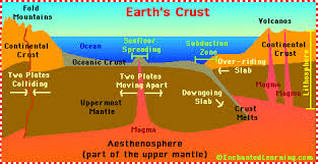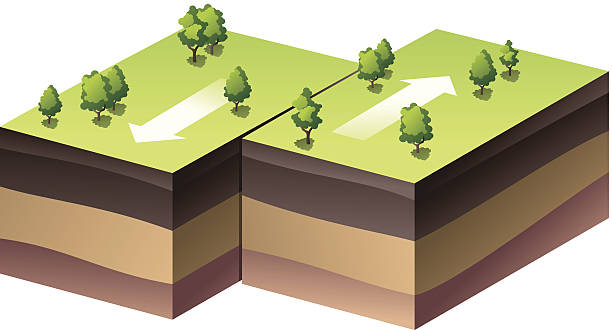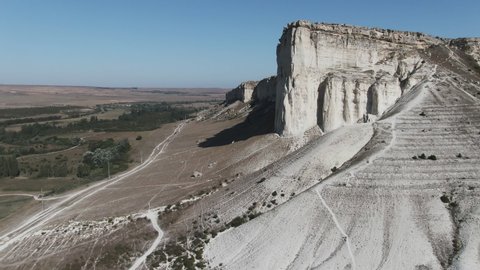The Earth is in a constant state of change. Earth’s crust, called the lithosphere, consists of 15 to 20 moving tectonic plates. The plates can be thought of like pieces of a cracked shell that rest on the hot, molten rock of Earth’s mantle and fit snugly against one another. The heat from radioactive processes within the planet’s interior causes the plates to move, sometimes toward and sometimes away from each other. This movement is called plate motion, or tectonic shift.
Our planet looks very different from the way it did 250 million years ago, when there was only one continent, called Pangaea, and one ocean, called Panthalassa. As Earth’s mantle heated and cooled over many millennia, the outer crust broke up and commenced the plate motion that continues today.

The huge continent eventually broke apart, creating new and ever-changing land masses and oceans. Have you ever noticed how the east coast of South America looks like it would fit neatly into the west coast of Africa? That’s because it did, millions of years before tectonic shift separated the two great continents.
Earth’s land masses move toward and away from each other at an average rate of about 0.6 inch a year. That’s about the rate that human toenails grow! Some regions, such as coastal California, move quite fast in geological terms — almost two inches a year — relative to the more stable interior of the continental United States. At the “seams” where tectonic plates come in contact, the crustal rocks may grind violently against each other, causing earthquakes and volcano eruptions. The relatively fast movement of the tectonic plates under California explains the frequent earthquakes that occur there.
At its most powerful, education harnesses our natural curiosity as human beings to understand the universe and everything in it. This week on the blog, we’re exploring what it means to actually reach into knowledge – and why developers are at the forefront of how the next generation is learning about the world they live in.
There has been a recent tectonic shift in voting patterns. A tectonic shift in societal trends occurred in the 1960s Recent Examples on the Web The spreading, smashing and plunging of tectonic plates shapes far more than just geography. Aegis of Menhir (Avenging Shield - Aegis of Thorns - Reprisal). Ascension (Clarity of Purpose). Eye of Reckoning. Judgment (Crushing Verdict - Heart of Wrath). Righteous Fervor (Dreeg's Reproach - Consecration - Retribution). Vire's Might (Volcanic Might - Volcanic Stride - Tectonic Shift) Passive Skills.
Seeing a geological diagram in a textbook is one thing. But reaching out and creating massive volcanoes with your bare hands? Rearranging the continents by searching for hidden fossil patterns? Now you’ve got some magic in the classroom.
Educational gaming is on the verge of a major turning point, and one of the leading forces is Gamedesk – an LA-based research institute, commercial development studio, online community platform, and physical school.
Recently, Gamedesk released a lengthy white paper detailing how they built a set of “kinesthetic learning” games that teachers can use to teach complicated geoscience concepts to students aged 12 to 15. These include Leap Motion games GeoMoto and Pangean, which let you rearrange continents, shift tectonic plates, and form volcanoes. Pangean and Geomoto are both available for free download on Gamedesk’s websiteand on our Developer Gallery.
Pangean
Formerly known as Continental Drift, this puzzle game introduces the essentials of continental drift before moving on to plate tectonics. As a galactic member of the United Colonies, you travel the universe in your own scouting ship – using your hologram interface to piece together continents and demonstrate the shift that occurs over a hundred million years.
Use the fossil probe to reveal patterns in creature inhabitance and the sonar to scan for eroded portions of the continent. Your final mission? Returning present-day Earth to its Pangaea state! To help students absorb the lesson, teachers can ask: Why do you think the continents can be connected with each other? How did you use fossil remains to help you connect continents up? And why do you think similar fossils are found in different continents now?
Tectonic Shifting
GeoMoto
Building on their insights from the other three games in the series, GeoMoto (formerly Plate Tectonics) gives players a more direct relationship to geo-concepts. In other words, pulling, smashing, and grinding tectonic plates together!
Using the Leap Motion Controller, players navigate around a world with no geographic features, then shift and experience the motion of the plates with hand movements. You can see how plate tectonics create volcanoes, folded mountains, rift valleys, and seafloor spreading, then learn about different types of faults and the Richter scale.
Tectonic Shift Future


Tectonic Plate Shift Future

Tectonic Shift Blend

Kinesthetic Learning and the Future of Education
Geoscience is a complicated subject that involves thinking about the Earth as a fluid and complex system that’s constantly changing. These can be difficult concepts for kids, so Gamedesk used a kinesthetic learning approach to shed new light on the subject. This is a learning style that lets students engage physically with complex subjects through movement and action, rather than just watching a video.
Tectonic Shift Theory
Along with the creative and educational possibilities of virtual reality, we’re excited to see where motion-controlled gaming will take the next generation of students. You can download Pangean and Geomoto from Gamedesk’s website. Be sure to check out their white paper to learn about how the games were researched, built, and tested – including lesson plans and resources for teachers!
African Tectonic Plate Shift
Recommended Posts
